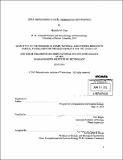| dc.contributor.advisor | Aviv Regev. | en_US |
| dc.contributor.author | Chan, Michelle M. (Michelle Mei Wah) | en_US |
| dc.contributor.other | Massachusetts Institute of Technology. Computational and Systems Biology Program. | en_US |
| dc.date.accessioned | 2013-10-24T17:30:59Z | |
| dc.date.available | 2013-10-24T17:30:59Z | |
| dc.date.copyright | 2013 | en_US |
| dc.date.issued | 2013 | en_US |
| dc.identifier.uri | http://hdl.handle.net/1721.1/81580 | |
| dc.description | Thesis (Ph. D.)--Massachusetts Institute of Technology, Computational and Systems Biology Program, 2013. | en_US |
| dc.description | Cataloged from PDF version of thesis. | en_US |
| dc.description | Includes bibliographical references. | en_US |
| dc.description.abstract | All the cells in the body contain the same genome yet showcase drastically different phenotypes. This is the result of different transcriptional programs, which are partly controlled by epigenetic modifications, including DNA methylation. In this thesis, I analyze genome-scale DNA methylation profiles across pre-implantation development to identify the targets and characterize the dynamics of global demethylation that lead to totipotency and the subsequent changes to embryonic specification. In Chapter 1, I validate and refine the decades old model for DNA methylation in mouse embryogenesis, identify many retrotransposons with active DNA methylation signatures at fertilization, and discover many, novel differentially methylated regions between the gametes that exist transiently during early development. Notably, the majority of epigenetic events unique to mammalian pre-implantation development are characterized in mouse. In Chapter 2, 1 describe the DNA methylation dynamics in human preimplantation development and show that the regulatory principles that operate in mouse are conserved, though some of their targets are species-specific and define regions of local divergence. Finally, in Chapter 3, I compare DNA methylation dynamics of fertilization to an artificial reprogramming process, somatic cell nuclear transfer, in mouse, and find that most dynamics are conserved but occur at a smaller magnitude after artificial reprogramming. I conclude this thesis with a summary of the chapters and a brief discussion of ongoing and future work. | en_US |
| dc.description.statementofresponsibility | by Michelle M. Chan. | en_US |
| dc.format.extent | 149 p. | en_US |
| dc.language.iso | eng | en_US |
| dc.publisher | Massachusetts Institute of Technology | en_US |
| dc.rights | M.I.T. theses are protected by
copyright. They may be viewed from this source for any purpose, but
reproduction or distribution in any format is prohibited without written
permission. See provided URL for inquiries about permission. | en_US |
| dc.rights.uri | http://dspace.mit.edu/handle/1721.1/7582 | en_US |
| dc.subject | Computational and Systems Biology Program. | en_US |
| dc.title | DNA methylation in early mammalian development | en_US |
| dc.title.alternative | Deoxyribonucleic acid methylation in early mammalian development | en_US |
| dc.type | Thesis | en_US |
| dc.description.degree | Ph.D. | en_US |
| dc.contributor.department | Massachusetts Institute of Technology. Computational and Systems Biology Program | |
| dc.identifier.oclc | 858804524 | en_US |
